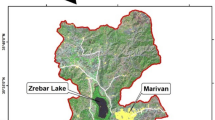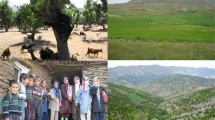Abstract
The development of ecotourism as one of the most economical ecosystem services requires the evaluation, planning, and management of sustainable development. By considering the challenges facing the management of touristic zones, especially in forested areas, the need to use an integrated approach to optimize “recreational activities” versus “conservation of natural resources” is inevitable. Therefore, in this study location of appropriate areas for developing ecotourism was analyzed with the use of combined analytic network process (ANP) and genetic algorithm (GA). A three-level network comprising the target, five main clusters (biodiversity, climatic and climatic resources, soil and geology, topography, and socioeconomic factors), and sub-selection criteria in the studied forest areas, are designed. Subsequently, standardized and related maps were provided as selection criteria in the GIS. Accordingly, the genetic algorithm was found to consider feasible sites and 10 optimal responses including 5 appropriate and 5 inappropriate sites. In order to ensure the optimality of the proposed GA, the desirable ratio between the superior and inappropriate sites and the comparison of the results with the zones obtained by the WLC method was used. The comparative results confirmed the efficiency of GA for identifying appropriate sites for ecotourism.






Similar content being viewed by others
References
Ahmadi M, Faraji Darabkhani M, Ghanavati E (2014) A GIS-based multi-criteria decision-making approach to identify site attraction for ecotourism development in Ilam Province, Iran. Tourism Plan Dev 12(2):176–189
Ahmadipari M, Hoveidi H, Jafari HR, Pazoki M (2018) An integrated environmental management approach to industrial site selection by genetic algorithm and fuzzy analytic hierarchy process in geographical information system. Glob J Environ Sci Manag 4(3):339–350
Aliani H, BabaieKafaky S, Saffari A, Monavari SM (2017) Land evaluation for ecotourism development—an integrated approach based on FUZZY, WLC, and ANP methods. Int J Environ Sci Technol 14:1999–2008
Bagheri M, Mohammadzadeh M (2016) Ranking of areas with ecotourism attractions using multiple criteria decision making (MCDM) (Case Study: Jask province). Q Geogr (Reg Plann) 7(1):7–16
Bali A, Monavari SM, Riazi B, Khorasani N, Kheirkhah Zarkesh MM (2015) A Spatial decision support system for ecotourism development in caspian hyrcanian mixed forests ecoregion. Bol Ciênc Geod Sec 21:340–353
Bunruamkaew K, Murayama Y (2011) Site suitability evaluation for ecotourism using GIS & AHP: A case study of Surat Thani province, Thailand. Procedia-Soc Behav Sci 21(1):269–278
Dreyfus-Leon M, Chen DG (2007) Recruitment prediction with genetic algorithms with application to the Pacific Herring fishery. Ecol Model 203:141–146
Duan QY, Sorooshian S, Gupta VK (1992) Effective and efficient global optimization for conceptual rainfall–runoff models. Water Resour Res 28(4):1015–1031
Duan QY, Gupta VK, Sorooshian S (1993) Shuffled complex evolution approach for effective and efficient global minimization. J Optim Theory Appl 76:501–521
Duan QY, Sorooshian S, Gupta VK (1994) Optimal use of the SCE–UA global optimization method for calibrating watershed models. J Hydrol 158(3–4):265–284
Ghahroodi Tali M, Sadoogh MN (2012) Site selection for ecotourism with emphasis red list IUCN case study Miankaleh peninsula Iran. In: 32nd International geographical congress in cologne. Germany
Goldberg DE (1989) Genetic algorithms in search, optimization, and machine learning. Addison Wesley, Boston
Hajehforooshnia Sh, Soffianian A, Salman Mahiny AR, Fakheran S (2011) Multi objective land allocation (MOLA) for zoning Ghamishloo Wildlife Sanctuary in Iran. J Nat Conserv 19(4):254–262
Holland JH (1975) Adaptation in natural and artificial systems. The University of Michigan Press, Ann Arbor
Holzkamper A, Lausch A, Seppelt R (2006) Optimizing landscape configuration to enhance habitat suitability for species with contrasting habitat requirements. Ecol Model 198(3–4):277–292
Jaafari A, Najafi A, Zenner EK (2014) Ground-based skidder traffic changes chemical soil properties in a mountainous Oriental beech (Fagus orientalis Lipsky) forest in Iran. J Terramech 55:39–46
Jaafari A, Najafi A, Rezaeian J, Sattarian A (2015) Modeling erosion and sediment delivery from unpaved roads in the north mountainous forest of Iran. GEM Int J Geomath 6(2):343–356
Mafi-Gholami D, Zenner EK, Jaafari A, Ward RD (2019) Modeling multi-decadal mangrove leaf area index in response to drought along the semi-arid southern coasts of Iran. Sci Total Environ 656:1326–1336
Menon A (ed) (2004) Frontiers of evolutionary computation. Kluwer Academic Publishers, Dordrecht
Naqinezhad A, Ramezani E, Djamali M, Schnitzler A, Arnold C (2018) Wild grapevine (Vitis vinifera subsp. sylvestris) in the Hyrcanian relict forests of northern Iran: an overview of current taxonomy, ecology and palaeorecords. J For Res 29(6):1757–1768
Parolo G, Ferrarini A, Rossi G (2009) Optimization of tourism impacts within protected areas by means of genetic algorithms. Ecol Model 220(8):1138–1147
Peacor SD, Allesina S, Riolo RL, Hunter TS (2007) A new computational system, DOVE (Digital Organisms in a Virtual Ecosystem), to study phenotypic plasticity and its effects in food webs. Ecol Model 205(1–2):13–28
Podger G (2005) Rainfall Runoff Library (RRL). Catchment modeling toolkit prepared by the © CRC for catchment hydrology, Australia, p 110
Possingham HP, Ball IR, Andelman S (2000) Mathematical methods for identifying representative reserve networks. In: Ferson S, Burgman M (eds) Quantitative methods for conservation biology. Springer, New York, pp 291–305
Rahimi S, Shadman Roodposhti M, Abbaspour AR (2014) Suitable areas for the artificial groundwater recharge. Environ Earth Sci 6:1979–1992
Rosenbrock HH (1960) An automatic method for finding the greatest or least value of a function. Comput J 3(3):175–184
Sarkar S, Aggarwal A, Garson J, Margules C, Zeidler J (2002) Place prioritization for biodiversity content. J Biosci 27:339–346
Sheikh Goodarzi M, Sakieh Y, Navardi S (2017) Measuring the effect of an ongoing urbanization process on biodiversity conservation suitability index: integrating scenario-based urban growth modeling with Conservation Assessment and Prioritization System (CAPS). Geocarto Int 32:834–852
Song M, Chen D (2018) An improved knowledge-informed NSGA-II for multi-objective land allocation (MOLA). Geo-spatial Inf Sci 21(4):273–287
Sweeney AW, Beebe NW, Cooper RD (2007) Analysis of environmental factors influencing the range of anopheline mosquitoes in northern Australia using a genetic algorithm and data mining methods. Ecol Model 203:375–386
Acknowledgements
The authors wish to thank all who assisted in conducting this work.
Author information
Authors and Affiliations
Corresponding author
Additional information
Editorial responsibility: M. Abbaspour.
Rights and permissions
About this article
Cite this article
MirarabRazi, J., Hassanzad Navrodi, I., Ghajar, I. et al. Identifying optimal location of ecotourism sites by analytic network process and genetic algorithm (GA): (Kheyroud Forest). Int. J. Environ. Sci. Technol. 17, 2583–2592 (2020). https://doi.org/10.1007/s13762-020-02633-z
Received:
Revised:
Accepted:
Published:
Issue Date:
DOI: https://doi.org/10.1007/s13762-020-02633-z




